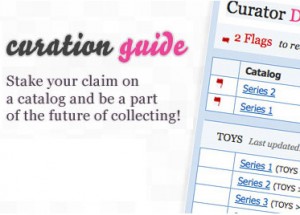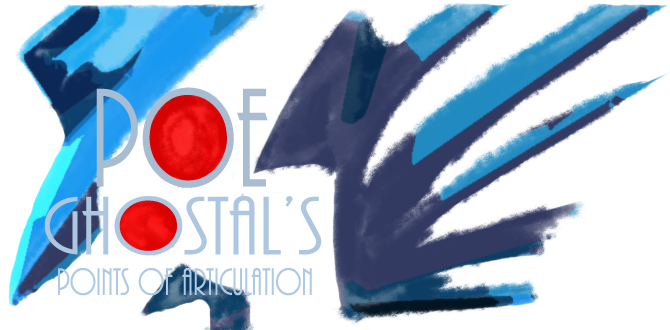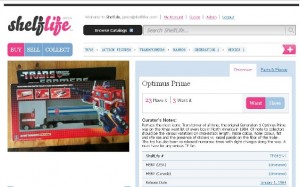When you run a toy-oriented website (or any website, really) with a respectable amount of traffic, you eventually start to receive unsolicited emails. Most of the time they’re either unrelated to the topic of the website, press releases, or just boring. Once in a while, though, I receive an email that intrigues me and I think merits further investigation.
A few months back I got an email from the folks at ShelfLife (www.shelflifex.com), a new website whose three stated goals are:
- To create a free encyclopedia of every collectible ever made
- To provide the best collection management tools, community features and collectibles news aggregation yet seen
- To make Ebay useless to collectors by launching a next generation marketplace that blows that old tech away
Lofty goals, of course, and time will tell successful they are at reaching them. But I visited the site out of curiosity and found something that had been lacking in my previous test-drives of similar sites: an easy-to-use, intuitive interface.
I wrote back to ShelfLife CEO James Chillcott to find out more about the project.
1.) What is the concept behind Shelf Life?
ShelfLife is designed to be the ultimate collector’s platform. We also like to refer to it as the future of collecting. At the heart of the project is a collector-focused attitude aimed at giving collectors of all types the best of everything all in one place. Everyone on the team is a passionate and experienced collector in their own right and we’ve all been frustrated and disappointed in one way or another by how disjointed the collecting experience is in 2012.
We’re all using dozens of sites to hang out, research and acquire our collections. A lot of this has to do with a lack of evolution by Ebay over the years, where a lot of the marketplace activity has been centered. They enjoy a near-monopoly on after-market sales, and that’s never good for the users.
It’s also a function of the fact that many of the best fan sites have been built out as passion projects using off-the-shelf tools that didn’t really allow for the level of system sophistication that collectors will find on ShelfLifex.com. With ShelfLife, we simply asked ourselves what we wanted as collectors and set out to give that to the fans. Ultimately that means an evolution towards a beautiful layering of product data, marketplace functions, social tools and news aggregation that we hope will blow our users away as our build out progresses.
2.) How will your marketplace work, particularly in conjunction with the catalog functionality?
It’s important to point out that ShelfLife is equal parts Wikipedia, Ebay and Facebook. We’re trying to build a perfect record of every collectible ever made, and then surround that with a next generation marketplace and elegant social tools. The beauty of this model is that with a collectibles encyclopedia built into the system, you can do some pretty amazing things with your marketplace. Most e-commerce operations rely on code that basically tries to guess what you are looking for to make recommendations. On ShelfLife, we track products down to the item level, meaning that we track every little accessory, gun, and piece of paperwork that comes with your collectible. When our users enter a WANT into the site, we can let them express that desire far more accurately than on any other site. That way, when another collector or vendor enters the corresponding HAVE or SALE into the site we can automatically match them with a buyer. That’s a huge deal.
It also allows you to get rid of time based auctions entirely, which we see as an utterly outdated mode of online sales. With the advent of sniping software, we’ve all been the victim of ridiculous situations where 27 of us waste a week bidding on and tracking an auction only to get sniped at the last second by a bot. What kind of modern marketplace wastes a week failing to connect 95% of buyers with the product they want? The inefficiency is staggering and text-based Buy/Sell/Trade lists are even worse. SL allows buyers and sellers to simply locate the relevant collectible, tell us what they want to pay for it or sell it for, and then either get matched immediately with their best option or placed into a queue so that they will be matched the moment a relevant opportunity becomes available. Our beta testers have already entered 25,000+ Haves and Wants into the system and the potential transaction volume looks very promising.
Later this summer we’ll be launching both deposit and pre-order options, which will expand the flexibility of the marketplace and allow for even smoother collection patterns. Imagine being able to pre-order an entire line of Transformers the day they are announced, at prices below MSRP and having that contract fulfilled by a minimum number of sellers that will plan your shipping patterns to minimize your total cost. Imagine not having to hit every Target in a 50-mile radius just to find the last thing you need for your set at a reasonable price. Imagine now having to fill out a huge form every time you want to put something up for sale. Or how about multi-user trades that result in matches never before possible? We’re pretty excited about the impact on the collecting experience.
[Poe’s note: I’ll follow up with more on the marketplace section of Shelflife once it launches.]
3.) What else will Shelf Life offer that differs from other websites that provide similar services?
There are a few other major differences already and some amazing stuff coming down the pipe later this summer and fall. First, our collection management tools will be unparalleled. You’ll now be able to translate a transaction history automatically into a record of your collection, track the rise and fall of the value of your various collectibles, and to share and show off your collection and connect with like-minded collectors in fun and exciting ways you’ve never even considered until now.
Our social tools will provide core community building functionality that will helps collectors connect in new, game oriented ways, show off collection photos and share experiences while connecting fully with Facebook, Twitter, Pinterest and the rest. And of course the final version of the marketplace is going to be as close to a perfect system as collectors have every seen, especially if the community fully engages in our feedback programs and helps craft our growth. We’re a team of collectors first, and web folk second…we won’t be happy until we’ve solved the things that annoy all of us. Forcing realistic shipping charges for instance is top of our list for a fix before the end of 2012.
For vendors, we intend to provide a premium service level (at half the cost of Ebay) that offers end-to-end inventory management, predictive sales tools and the ability to publish sales out easily beyond our walls into other important marketplaces. See we want to be the center of this ecosystem, but we also recognize the value to collectors and vendors both of being able to share information in all directions, to keep options open and to nurture the growth of the industry and the fans across the board.
4.) What is a curator, and how do you become one?
A curator is a passionate collectibles fan that takes on the role of a volunteer editor for one or more specific catalogs of collectibles within ShelfLife. With hundreds of thousands of collectibles to record, it’s not practical for us to enter them all ourselves. So we came up with the curator model to increase fan participation and allow natural leaders in the various communities to help control the evolution of ShelfLife and ensure the accuracy of the product data that matters to them the most.
 If you think about how Wikipedia works, and how Wikipedia editors function within that platform, then ShelfLife curation will seem fairly straight forward. The idea is for curators to take on a catalogue at a time, collecting all the necessary information on MSRP, Release Dates, Manufacturer, Character, Items List, Photos, etc for all of the relevant products. Curators also get to provide editorial style comments on their catalogs and each of the Products, providing a bit of personal flavor to every catalog. We take the catalogs live, the site grows and as a thank-you for their hard work, the sellers in that catalog give a small piece of the total sales commission to the curator each time they sell. Regular collectors can then review the product information and make suggestions for correction or updates in wiki style. The goal is to hit 95%+ accuracy across the platform on first posting, and 99% within a few months of catalog launches by letting the community fill in the blanks.
If you think about how Wikipedia works, and how Wikipedia editors function within that platform, then ShelfLife curation will seem fairly straight forward. The idea is for curators to take on a catalogue at a time, collecting all the necessary information on MSRP, Release Dates, Manufacturer, Character, Items List, Photos, etc for all of the relevant products. Curators also get to provide editorial style comments on their catalogs and each of the Products, providing a bit of personal flavor to every catalog. We take the catalogs live, the site grows and as a thank-you for their hard work, the sellers in that catalog give a small piece of the total sales commission to the curator each time they sell. Regular collectors can then review the product information and make suggestions for correction or updates in wiki style. The goal is to hit 95%+ accuracy across the platform on first posting, and 99% within a few months of catalog launches by letting the community fill in the blanks.
Over 120 curators have built out over 300 catalogs on ShelfLifex.com so far. Building a catalogue takes 1-5 hours on average and we usually allow for a couple of weeks to accomodate busy schedules. Potential curators that would like to apply can learn all about it over here:
http://www.shelflifex.com/
and here:
http://www.cybertron.ca/
and then apply via everyone@shelflifex.com.
5.) What plans do you have for Shelf Life in the future?
Our vision for SL is long term. We plan to be around for a while. Once we get the core marketplace functions launched at the end of May, 2012, we’ll be moving on to a broad set of upgrades aimed at perfecting the core site tools. Towards the end of summer we’ll be rolling out our mobile strategy, which will unleash some very cool Sightings tools that we think will save collectibles hunters a ton of time and money. There are plans for some very special exclusive collectibles releases through the site that will be unlocked based on user participation and we’ve even started planning a very special video game that we’ll talk more about towards the end of the year.
In the end it’s all about the fans. We spend a lot of money, passion and time and we deserve a better playground.


